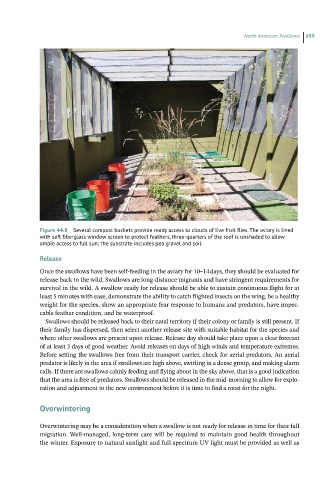Page 698 - Hand rearing birds second
P. 698
North American Swallows 699
Figure44.8 Several compost buckets provide ready access to clouds of live fruit flies. The aviary is lined
with soft fiberglass window screen to protect feathers, three-quarters of the roof is unshaded to allow
ample access to full sun; the substrate includes pea gravel and soil.
Release
Once the swallows have been self‐feeding in the aviary for 10–14 days, they should be evaluated for
release back to the wild. Swallows are long‐distance migrants and have stringent requirements for
survival in the wild. A swallow ready for release should be able to sustain continuous flight for at
least 5 minutes with ease, demonstrate the ability to catch flighted insects on the wing, be a healthy
weight for the species, show an appropriate fear response to humans and predators, have impec-
cable feather condition, and be waterproof.
Swallows should be released back to their natal territory if their colony or family is still present. If
their family has dispersed, then select another release site with suitable habitat for the species and
where other swallows are present upon release. Release day should take place upon a clear forecast
of at least 3 days of good weather. Avoid releases on days of high winds and temperature extremes.
Before setting the swallows free from their transport carrier, check for aerial predators. An aerial
predator is likely in the area if swallows are high above, swirling in a dense group, and making alarm
calls. If there are swallows calmly feeding and flying about in the sky above, that is a good indication
that the area is free of predators. Swallows should be released in the mid‐morning to allow for explo-
ration and adjustment to the new environment before it is time to find a roost for the night.
Overwintering
Overwintering may be a consideration when a swallow is not ready for release in time for their fall
migration. Well‐managed, long‐term care will be required to maintain good health throughout
the winter. Exposure to natural sunlight and full‐spectrum UV light must be provided as well as

